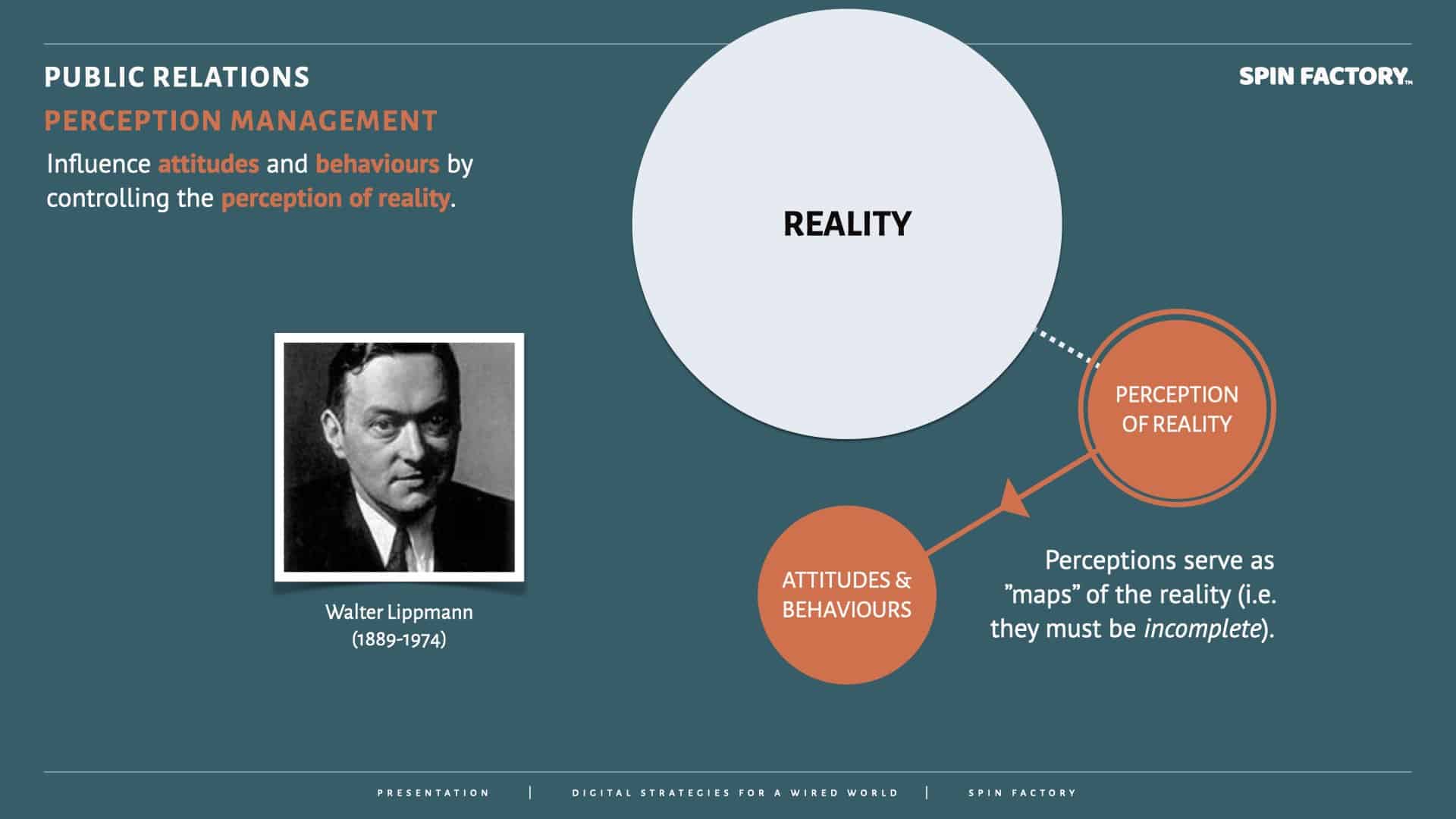Perception management is a potent PR approach.
Managing perceptions is a PR approach that shapes narratives to influence how publics interpret and responds to information, events, or organisations.
Here we go:
Perception Management
Perception management is a strategic PR method that seeks to influence how audiences interpret and respond to information, events, or organisations. The fundamental idea is that perception, not reality, dictates human behaviour.
What people believe to be factual matters more than what is objectively true regarding decision-making, public opinion, and reputation.
In PR, perception management involves:
Managing perceptions is especially critical in public affairs, corporate communications, crisis communications, and media relations. When used manipulatively, it is also closely related to propaganda.
The research on perception management is focused on how organisations can create a desired reputation:
“The OPM [Organizational Perception Management] field focuses on the range of activities that help organisations establish and/or maintain a desired reputation (Staw et al., 1983). More specifically, OPM research has primarily focused on two interrelated factors: (1) the timing and goals of perception management activities and (2) specific perception management tactics (Elsbach, 2006).”
Source: Organization Development Journal 3Hargis, M. & Watt, John. (2010). Organizational perception management: A framework to overcome crisis events. Organization Development Journal. 28. 73 – 87. … Continue reading
Perceptions of Reality
How does perception management work?
Walter Lippmann (1889 – 1974) proposed that our perceptions of reality differ from the actual reality. The reality is too vast and too complex for publics to process. 4Lippmann, Walter. 1960. Public Opinion (1922). New York: Macmillan.
Alas, no one bases their attitudes and behaviours on reality; we base them on our perceptions of reality.
Therefore, the strategic management of perceptions and narratives has far-reaching implications: If you can control people’s “pictures in their heads,” you can control their attitudes and behaviours.
One who effectively manages the perceptions of publics acts as a moral legislator, capable of shaping attitudes and behaviours according to the categorical imperative.
Today, the “pictures in our heads” are influenced not only by traditional news media, but also by influencers, search engines, and social media algorithms. Therefore, perception management is more critical than ever.
Learn more: Perception Management
Walter Lippmann and Perception Management
In his seminal work Public Opinion (1922), Walter Lippmann laid the intellectual groundwork for the idea that perception and reality are not the same — a core principle of modern perception management. 5Lippmann, Walter. 1960. Public Opinion (1922). New York: Macmillan.
Lippmann argued that:
Lippmann’s ideas resonate deeply with perception management in public relations.
“We are all captives of the picture in our head — our belief that the world we have experienced is the world that really exists.”
— Walter Lippmann (1889 – 1974)
On Creating Pseudo-Environments
Lippmann coined the term “pseudo-environment,” which describes the filtered, biased, and often artificial version of reality presented by the media. He warned that influential elites could exploit this manufactured reality to manipulate public thought and behaviour.
Lippmann was sceptical about the public’s ability to discern reality from the pseudo-environment, which raises ethical concerns:
Perception management is not inherently sinister, but as Lippmann warned, it places immense power in the hands of those controlling the narrative.
In essence, perception management is the applied PR version of Lippmann’s media critique. It acknowledges that facts alone do not win public trust—priming, framing, storytelling, and emotional appeal do.
Learn more: Perception Management

THANKS FOR READING.
Need PR help? Hire me here.

What should you study next?
Spin Academy | Online PR Courses

Spin’s PR School: Free Persuasion PR Course
Use this free Persuasion PR Course to elevate your public relations game with powerful insights. Drive impact and influence like never before.
Persuasion 101
Advanced Persuasion
Propaganda
Learn more: All Free PR Courses
💡 Subscribe and get a free ebook on how to get better PR.

Annotations
| 1 | Silfwer, J. (2023, December 3). Priming in PR. Doctor Spin | The PR Blog. https://doctorspin.net/priming-in-pr/ |
|---|---|
| 2 | Silfwer, J. (2023, December 3). Framing in PR. Doctor Spin | The PR Blog. https://doctorspin.net/framing-in-pr/ |
| 3 | Hargis, M. & Watt, John. (2010). Organizational perception management: A framework to overcome crisis events. Organization Development Journal. 28. 73 – 87. https://www.researchgate.net/publication/288292596_Organizational_perception_management_A_framework_to_overcome_crisis_events |
| 4 | Lippmann, Walter. 1960. Public Opinion (1922). New York: Macmillan. |
| 5 | Lippmann, Walter. 1960. Public Opinion (1922). New York: Macmillan. |



